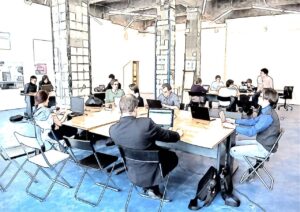This article explores collaborative solutions in environmental consulting, highlighting the necessity and impact of partnership in achieving sustainable results. Discover how unity in environmental consulting is revolutionizing the way we tackle our planet’s challenges. Through real-world case studies from iEnvi’s extensive experience, we unveil the transformative power of collective effort, innovation, and shared objectives. From remediation efforts to compliance strategies and sustainable development, this exploration showcases the effectiveness of collaboration in producing comprehensive outcomes that benefit the environment and all stakeholders. Immerse yourself in the journey of discovering the essence of successful teamwork in environmental consulting with vivid examples.
Collaborative Solutions for Environmental Challenges
In the evolving field of environmental consulting, the importance of collaborative solutions cannot be overstated. This approach, which combines expertise from various disciplines, offers innovative and effective strategies for tackling environmental challenges. Environmental consulting, particularly in Australia, requires a comprehensive understanding of the natural environment, the impact of human activities, and the complex regulatory landscape. This understanding is critical in developing management plans that are not only effective but also climate resilient.
Enhancing Coastal Resilience
A collaborative project in Adelaide focused on enhancing coastal resilience against climate change impacts. Environmental consultants, marine biologists, and climate experts developed a comprehensive strategy to protect coastal ecosystems. Their approach included restoring natural barriers, implementing sustainable shoreline management plans, and educating local communities about climate resilient practices.
Urban Green Space Development
In Brisbane, a unique collaboration among environmental planners, local governments, and community groups led to the development of new urban green spaces. These spaces not only improved air quality but also provided recreational areas that enhance the mental and physical health of residents. The project demonstrated how environmental services can be integrated into urban planning to create healthier, more sustainable cities.
Waste Management and Recycling Initiatives
Melbourne saw a groundbreaking project where environmental consultants worked with waste management experts and local businesses to implement innovative recycling initiatives. These efforts significantly reduced landfill waste and paved the way for more sustainable industrial practices, showcasing the importance of collaborative solutions in managing environmental impacts.
Biodiversity Conservation Strategies
In Sydney, a team of environmental consultants, wildlife biologists, and local authorities developed strategies to protect and conserve local biodiversity. This collaboration resulted in the successful rehabilitation of several endangered species and the preservation of critical habitats, emphasizing the need for a holistic approach to environmental assessment and conservation.
Water Resource Management
A project in Queensland brought together hydrologists, environmental engineers, and agricultural experts to address water scarcity and quality issues. Their collaborative efforts led to the development of advanced water resource management plans, ensuring sustainable water use and quality for both urban and rural communities. This project highlighted the range of environmental expertise necessary to tackle complex water-related challenges.
Case Studies of Successful Collaborative Environmental Consulting Projects

Contaminated Land Remediation in Gold Coast
A multidisciplinary team in Gold Coast undertook a large-scale contaminated land remediation project. The team included environmental consultants, chemists, and engineers who worked together to assess and mitigate soil and groundwater contamination. Their innovative remediation techniques not only restored the land but also ensured its safe future use, exemplifying successful environmental consulting.
Air Quality Improvement in Adelaide
In Adelaide, a collaboration between air quality experts, environmental consultants, and public health officials led to a significant improvement in the city’s air quality. By implementing targeted strategies to reduce emissions and promoting green transportation options, the project showcased how collaborative approaches can effectively address environmental challenges.
Sustainable Agriculture Practices in Rural Victoria
A team of environmental consultants, agronomists, and local farmers in Victoria developed sustainable agriculture practices to reduce environmental impacts and enhance crop yields. Their collaborative efforts demonstrated how environmental consulting can contribute to more sustainable and profitable farming methods.
Industrial Pollution Control in Sydney
Environmental engineers and consultants in Sydney worked together with industrial facilities to develop and implement pollution control measures. This collaboration resulted in significant reductions in industrial emissions and effluents, showcasing the effectiveness of cooperative approaches in tackling industrial environmental challenges.
Renewable Energy Development in Brisbane
In Brisbane, a collaborative project involving environmental consultants, renewable energy experts, and government agencies led to the development of several renewable energy installations. This initiative not only provided sustainable energy solutions but also set a precedent for future renewable energy projects in Australia.
These case studies demonstrate the powerful impact of collaborative solutions in environmental consulting. By bringing together diverse expertise and perspectives, these projects address environmental challenges effectively and pave the way for a more sustainable future.
The Benefits of Collaborative Environmental Consulting
Collaborative environmental consulting offers several benefits.
- Comprehensive Environmental Assessment: Collaborative efforts allow for a more thorough environmental assessment. By pooling the expertise of different specialists, such as biologists, chemists, and geologists, a more complete understanding of the environmental situation is achieved.
- Enhanced Environmental Services: Collaboration leads to enhanced environmental services. This includes improved data collection, analysis, and reporting, which are critical for developing effective environmental strategies.
- Innovative Solutions for Environmental Impacts: Diverse teams often lead to more creative and innovative solutions. This is particularly important in finding new ways to mitigate environmental impacts, such as pollution reduction and habitat restoration.
- Development of Effective Management Plans: Collaborative consulting facilitates the creation of robust and adaptive management plans. These plans can effectively address a range of environmental issues, from waste management to resource conservation.
- Fostering Climate Resilient Strategies: The pooling of knowledge from different disciplines helps in crafting strategies that are not only effective in the present but are also resilient to future climate changes. This foresight is essential in long-term environmental planning.
How to Implement Collaborative Environmental Consulting
Implementing collaborative environmental consulting requires careful planning and coordination. Here are some key steps and considerations:
- Identify and Assemble Diverse Expertise: Begin by identifying the range of environmental expertise needed for the project. This could include specialists in air quality, water management, soil science, and regulatory compliance.
- Establish Clear Communication Channels: Effective communication is vital in collaborative efforts. Establishing clear and open channels of communication ensures that all team members are on the same page and can share ideas and feedback effectively.
- Set Shared Goals and Objectives: Aligning the team around common goals is crucial. This includes not just the end objectives but also the approach to achieving them, ensuring that all actions are cohesive and directed towards a common purpose.
- Utilize Environmental Management Systems: Implementing structured environmental management systems can help in coordinating the efforts of different experts. These systems provide frameworks for tracking progress, assessing risks, and ensuring compliance with environmental regulations.
- Encourage Innovation and Flexibility: Encourage team members to think creatively and be open to new ideas. Environmental challenges often require innovative solutions, and a flexible approach allows the team to adapt to new information or changing circumstances.
- Integrate Local and Global Knowledge: Combining local environmental knowledge with global best practices can lead to more effective solutions. This integration ensures that strategies are relevant to the specific context while also benefiting from broader insights and experiences.
- Regular Review and Adaptation: Environmental projects are dynamic, and regular review and adaptation are necessary. This ensures that the strategies remain effective and relevant, even as conditions change.
Real-World Examples of Collaborative Environmental Consulting
Real-world examples of collaborative environmental consulting further illustrate its effectiveness. In Brisbane, a project focused on improving air quality in an urban area saw environmental consultants working alongside city planners and public health experts. Their combined efforts led to the development of a comprehensive air quality management plan that addressed the root causes of pollution while considering the health and well-being of residents. Here are five additional real-world examples that demonstrate its effectiveness:
- Great Barrier Reef Conservation Project, Queensland: A collaborative effort involving marine biologists, climate scientists, and local communities focused on preserving the Great Barrier Reef. This project combined advanced environmental assessment techniques with traditional knowledge, leading to innovative strategies for coral conservation and water quality management.
- Urban Greening Initiative, Melbourne: This project brought together environmental consultants, urban planners, and community organizations to transform urban spaces into green, sustainable areas. The initiative aimed to improve air quality and create climate resilient urban ecosystems, demonstrating the power of collaborative environmental solutions in urban settings.
- Coastal Erosion Management, Sydney: A team of geologists, oceanographers, and environmental engineers collaborated on a project to manage coastal erosion. Their integrated approach led to the development of sustainable, long-term strategies to protect coastal areas, balancing natural environment preservation with the needs of local communities.
- Industrial Pollution Reduction, Adelaide: Environmental consultants worked with industrial engineers and local regulatory bodies to reduce pollution from a major industrial site. Their collaborative efforts resulted in innovative waste management and pollution control techniques that significantly reduced environmental impacts.
- Renewable Energy Development, Perth: A collaboration between environmental consultants, energy experts, and government agencies led to the successful implementation of a large-scale renewable energy project. This initiative not only addressed environmental impacts but also set a precedent for sustainable energy development in Australia.
The Future of Collaborative Environmental Consulting
Looking forward, the future of collaborative environmental consulting seems bright. As environmental challenges become more complex, the need for diverse expertise and innovative approaches will only grow. This collaborative model not only addresses current environmental issues but also paves the way for creating more sustainable and climate-resilient communities. Here are several key trends and expectations:
- Increased Focus on Sustainable Solutions: As awareness of environmental impacts grows, there will be a heightened focus on developing sustainable and climate resilient strategies. Collaborative consulting will play a crucial role in crafting these solutions.
Integration of Technology and Big Data: The use of advanced technologies and big data in environmental assessment and management will increase. Collaborative efforts will likely incorporate more of these technological solutions, enhancing the accuracy and efficiency of environmental services.
- Global and Local Knowledge Synergy: The future will see a stronger synergy between global best practices and local environmental knowledge. This approach will ensure that solutions are not only effective on a global scale but also tailored to local needs and conditions.
- Expansion of Interdisciplinary Teams: The scope of collaborative teams will expand, incorporating a wider range of environmental and related disciplines. This expansion will enrich the pool of expertise available for tackling complex environmental challenges.
- Adaptive Management Strategies: The dynamic nature of environmental issues will necessitate more adaptive management plans. Collaborative consulting will evolve to be more agile and responsive to changing environmental conditions and scientific advancements.
These trends indicate a future where collaborative environmental consulting becomes increasingly vital in addressing the complex and evolving environmental challenges of our world.
Collaborative solutions in environmental consulting are crucial for addressing the multifaceted challenges facing our natural environment. By bringing together a range of expertise and perspectives, these collaborations foster innovative, effective, and sustainable solutions. As we move forward, the integration of such collaborative approaches will be pivotal in ensuring the health and resilience of our environment.


